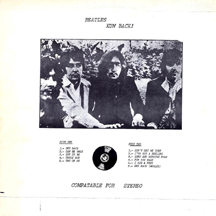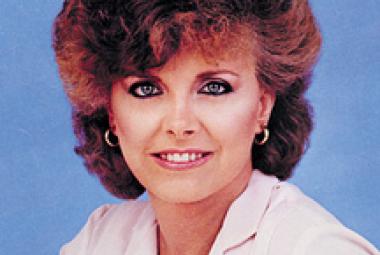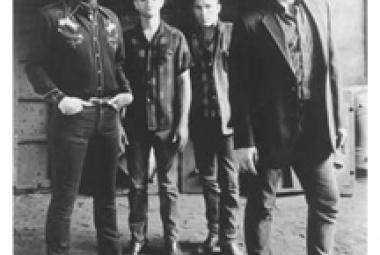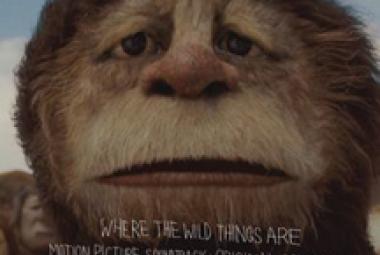THE BEATLES – KUM BACK
Before I get into The Iguana Chronicles – the series of albums of Stooges music put out by Greg Shaw of Bomp! Records – I’ll take some time to relate my early acquisitions of albums of this kind. There are records out there which are not authorized that can include recordings that fans cannot get any other way. They are usually referred to as “bootleg” records and consist of music that was never officially released. “Pirated” records are illegal copies of major-label releases, and they are a different thing altogether. That is what got Napster into so much trouble many years ago. Bootlegs exist in a grey area and are generally (if grudgingly) tolerated by the music industry. In the same way, the major record labels almost never try to retake possession of the early promo copies of albums that are supplied to DJ’s and rock critics ahead of the official releases, even though they are typically marked with something like: “Licensed for promotional use only. Sale is prohibited.”
That memorable time – I always thought it was late 1969, but based on the dates I see in Wikipedia and elsewhere, it must have been in 1970 – I went by the Record Bar in Raleigh near the North Carolina State University campus, and there were several tables full of bootleg records that had been set up in the middle of the store. I picked up four that day: two by Bob Dylan, Great White Wonder and John Birch Society Blues; one by the Beatles, Kum Back; and one by the Rolling Stones, The Greatest Group on Earth. The music I got that day was a revelation and has informed my record collecting habits ever since.
* * *
My bootleg album by the Beatles, Kum Back turned out to be a remarkable piece of vinyl: an early mix of their final album, Let it Be as recorded on acetate in August 1969 that was put together by Glyn Johns and with apparently minimal involvement by George Martin, who had produced virtually all of the other Beatles records. (An acetate disk is a low-quality type of phonograph record that is normally intended only for temporary use; it wears out quickly if played repeatedly). The title Kum Back I figure is sort of a takeoff on two 1969 Beatles singles, “Come Together” and “Get Back”; also, Get Back was the original working title for the Let it Be project, meant to be “a return to the Beatles’ earlier, less complicated approach to music” (as expressed in Wikipedia). As an illustration of this, the photograph for the planned cover for Get Back was taken in the same location as the one on the Beatles’ first British album, Please Please Me, and the cover had a similar design.
Kum Back was essentially recorded live, though evidently in a studio setting; and Get Back was planned for release in this same manner, as a back-to-roots move. As it turned out, the album Let it Be as it was ultimately released on May 8, 1970 (more than a year after most if not all of the actual recordings by members of the Beatles had been made) was greatly different from this earlier intention as Get Back, with superstar producer Phil Spector remixing all of the songs – adding orchestra and choir sections to some songs; and editing, splicing and overdubs on others. By the time Let it Be was released, the Beatles had already officially broken up.
Richie Unterberger notes in his Allmusic review that Let it Be is “[t]he only Beatles album to occasion negative, even hostile reviews, [and] there are few other rock records as controversial as Let it Be”. I didn’t like it much myself, particularly since I had previously heard Kum Back, which (though raw and rough in places) is better in almost every respect than the official album.
* * *
One thing about Kum Back that I didn’t particularly like was the seemingly endless performance of “Teddy Boy”; unlike most of the songs on the album that became part of the Beatles’ Let it Be album, “Teddy Boy” was instead released as a song on Paul McCartney's first solo album, McCartney – this album actually came out in April 1970, the month before Let it Be. (McCartney is not the first solo album by a Beatle though; Wonderwall Music, a soundtrack album of Indian classical music for a film called Wonderwall, was released in November 1968 by George Harrison).
At nearly 6 minutes in length and almost 2 minutes longer than any of the other songs on Kum Back (according to the Wikipedia article), “Teddy Boy” seems even longer; while there are two verses, the song mostly consists of the chorus line – “He said, Mommy don’t worry, now Teddy boy’s here / Taking good care of you” – repeated multiple times with very minor wording changes.
* * *
Ultimately, a revised edition of Let it Be came out in 2003, due to the hostility by many to Phil Spector’s production efforts on the original album. It was called Let it Be . . . Naked and purportedly stripped the additions and corrections made by Spector to the original Beatles recordings. As with the Iggy Pop remix of the Stooges album Raw Power, however, successfully redoing an album that has been heard for many years by basically everyone having any interest at all in the music is easier said than done. Mark Deming notes in Allmusic: “In 1997, when Columbia made plans to issue a new edition of Raw Power, they brought in [Iggy] Pop to remix the original tapes and (at least in theory) give us the ‘real’ version we’d been denied all these years. Then the world heard Pop’s painfully harsh and distorted version of Raw Power, and suddenly [David] Bowie’s tamer but more dynamic mix didn't sound so bad, after all.”
* * *
As to the Beatles’ attitudes toward the Let it Be . . . Naked reissue, Wikipedia notes: “[Paul] McCartney in particular was always dissatisfied with the ‘Wall of Sound’ production style of the Phil Spector mixes of three tracks, especially for his song ‘The Long and Winding Road’, which he believed was ruined by the process. George Harrison gave his approval for the Naked project before he died. McCartney’s attitude contrasted with [John] Lennon’s from over two decades earlier. In his December 1970 interview with Rolling Stone magazine, Lennon had defended Spector’s work, saying, ‘He was given the s--ttiest load of badly recorded s--t – and with a lousy feeling to it – ever. And he made something out of it. . . . When I heard it, I didn't puke.’ Harrison and Ringo Starr also remained complimentary about Spector’s contribution, with Starr saying: ‘I like what Phil did. . . . There’s no point bringing him in if you’re not going to like the way he does it – because that’s [Wall of Sound] what he does.’”
So how did Let it Be . . . Naked go down 33 years after the original release of Let it Be? The same sort of muted comments that greeted the new version of Raw Power were in evidence here as well; Wikipedia lists some of them: Allmusic notes that Let it Be . . . Naked “is overall slightly stronger [than Let it Be] . . . a sleeker, slicker album”; Pitchfork notes that Let it Be . . . Naked is “not essential [. . .] though immaculately presented”; and Salon commented that Let it Be . . . Naked “stripped the original album of both John [Lennon]’s sense of humor and Phil Spector’s wacky, and at least slightly tongue-in-cheek, grandiosity.”
For myself, some tacky items stood out when I scanned the changes made in Let it Be . . . Naked that are listed in Wikipedia; they seem to go beyond adjusting whatever Phil Spector had added to the recordings. For “Dig a Pony”, Wikipedia states: “[The] error in second verse (the ‘because’ in [John] Lennon’s vocal track) [was] digitally corrected.” Similarly, in “Two of Us”, a “minor error in Lennon’s acoustic guitar performance [was] digitally corrected.” One of the live tracks, “I’ve Got a Feeling” is actually composed of “[a] composite edit of two takes from the rooftop concert”. After reading this, I have an image in my mind of a high school art student touching up an old master.
* * *
A tape of this early acetate of Let it Be made its way to America and was played on several US radio stations; it was later pressed into the bootleg album called Kum Back – as with The Greatest Group on Earth by the Rolling Stones, there are multiple editions of the album, though the title Kum Back is used consistently throughout as far as I know. While live concerts are almost always performed after the studio album comes out, Kum Back was made available many months before either the rooftop concert film called Let it Be was broadcast or Let it Be the album was released (they came out a few days apart in May 1970).
As to the tracks on Kum Back that did not show up on Let it Be, besides “Teddy Boy”, a performance for just under a minute of a blues song by Jimmy McCracklin called “The Walk” (also known as “Can He Walk”) also does not appear on Let it Be. The biggest surprise though is that one of the strongest songs made by the Beatles in their twilight years, “Don’t Let Me Down” – previously released in April 1969 as the b-side of the “Get Back” single – was also not included on Let it Be, though it was among the songs in the 2003 reissue, Let it Be . . . Naked. With the inclusion of “Don’t Let Me Down”, two short tracks, “Dig It” and “Maggie Mae” (not the same song as the Rod Stewart classic, “Maggie May”) were left off Let it Be . . . Naked. Together, these two songs run just 1:30; honestly, you’d think there would be enough room on the CD for them, too (neither appears on Kum Back either, though “Don’t Let Me Down” does).
From Wikipedia: “Written by [John] Lennon as an anguished love song to Yoko Ono, [‘Don’t Let Me Down’] was interpreted by Paul McCartney as a ‘genuine plea’, with Lennon saying to Ono, ‘I’m really stepping out of line on this one. I’m really just letting my vulnerability be seen, so you must not let me down.’ . . . Richie Unterberger of Allmusic called it ‘one of the Beatles’ most powerful love songs’.”
* * *
Anthology 3 includes numerous Beatles tracks from the Let it Be sessions that (as I remember) are likely the corresponding songs on Kum Back; in all, 12 of the 23 songs on the second CD are identified in Wikipedia as “Savile Row Sessions”, with recording dates ranging from January 22 through January 29, 1969. Among these songs are “Teddy Boy”, but with a much shorter running time of 3:18. Other performances on Anthology 3 from the Savile Row Sessions that have no connection to the Let it Be album are two of the Abbey Road songs, “She Came In Through the Bathroom Window” and “Oh! Darling”; a song called “Mailman, Bring Me No More Blues” that had been recorded by Buddy Holly in 1957 and was part of the Beatles’ live repertoire until 1962; and a medley of three rock and roll classics – “Rip It Up”, “Shake, Rattle and Roll” and “Blue Suede Shoes”.
(September 2017)















